FIDE WGP Shymkent: Koneru and Goryachkina сlose in
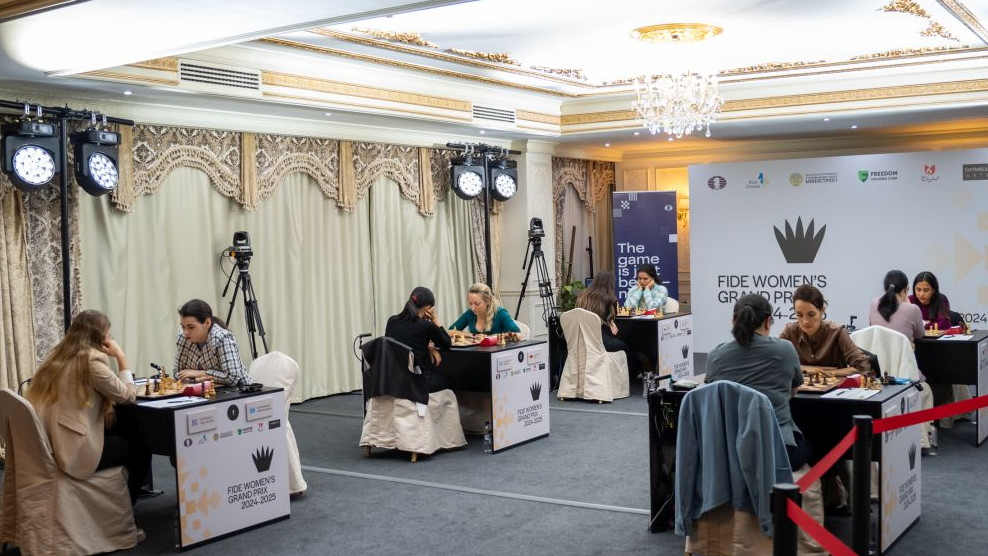
Another roller coaster of a day took place at the FIDE Women’s Grand Prix as, once again, the majority of games ended decisively, with Humpy Koneru and Aleksandra Goryachkina joining Tan Zhongyi as leaders of the event. Both Koneru and Goryachkina, after slow starts, are now making their presence felt with back-to-back wins, defeating Nurgyul Salimova and Stavroula Tsolakidou, respectively. Munguntuul Batkhuyag outplayed Kateryna Lagno in a surprising upset, while Elisabeth Paehtz and Bibisara Assaubayeva concluded their game with a quiet draw. Tan Zhongyi faced Divya Deshmukh in an intense battle, where Divya missed a crucial moment to take down the tournament leader. The leaderboard has now seen another shift, with new front-runners and promising matchups ahead. Tomorrow’s round will be crucial as Tan Zhongyi takes on Goryachkina, possibly reshuffling the standings once again. Let’s take a look at what happened in today’s games: Aleksandra Goryachkina – Stavroula Tsolakidou 1-0 Goryachkina has demonstrated deep preparation for the tournament, often taking her opponents into less popular sidelines. In today’s game, she played an improved version of a line we recently saw at the FIDE Olympiad in the game Cheparinov – Caruana, and by move 16, Aleksandra had a sizeable advantage. However, a few moves later, she offered a queen trade at the wrong time instead of securing a strong outpost for her knight. But she quickly corrected this error by repositioning the same knight to a3, forcing Black to make a few uncomfortable exchanges. With her back against the wall, Tsolakidou had to parry Goryachkina’s threats instead of creating her own. Eventually, Black crumbled, spending almost 20 minutes on a bad move in what was already a tough position. In the end, the black king found itself in the middle of the board, surrounded by danger, and Goryachkina sealed the game with a nice tactical finish: 44.Bxd5! 1-0 (44…Rxd4 45.cxd4+ followed by 46.Bxc6) Elisabeth Paehtz – Bibisara Assaubayeva ½-½ This quiet game featured a Sicilian Alapin, transitioning into an endgame where Paehtz’s isolated queen’s pawn became a slight liability. However, she held her ground with accurate defense, preventing Assaubayeva from gaining a substantial advantage. Black was only slightly better due to the more active rook, but White remained solid, playing accurately and not allowing her opponent to make inroads. The players eventually repeated moves, and the game concluded in a draw. Humpy Koneru – Nurgyul Salimova 1-0 In the day’s longest game, Koneru and Salimova fought in a battle spanning almost five hours. Relatively early, Humpy gained an advantage, but quickly let it slip, resulting in an imbalanced yet equal position. White had a queen, two rooks, and four pawns, versus Black’s queen, rook, two bishops, and two pawns. Typically, the bishop pair can be extremely dangerous in open positions, but unfortunately, but it was not the case as White had ample piece activity. Even though Salimova really pushed for an attack, it was to no avail, as Whit’s king was always safe and secure. White had two passed pawns that ran down the queenside, which at some point were overpushed, giving Black a chance to get back in the game, but with very little time on the clock, the best continuation (which involved rerouting pieces), was not an easy one to find. Salimova kept trying until the very end, but her attack was never enough, and eventually Humpy prevailed. This is Humpy’s second victory in a row. After drawing a completely winning position vs. Tan Zhongyi in the second round, she came back strong and now has some momentum. Lagno, Kateryna – Munguntuul, Batkhuyag Munguntuul and her Caro-Kann struck once again! White sidestepped theory early on, and neither player demonstrated accuracy in navigating the unchartered waters in the opening. In hopes of preparing some kind of attack on the kingside, Lagno swung her queen over but failed to gain ground, retreating instead, inadvertently giving Munguntuul time to build up an attack of her own. By move 22, Black was already much better, and suddenly Lagno found herself on the receiving end of a kingside attack, with Black’s two rooks and queen looming down on her king. Eventually, Lagno was forced to give up material, but her rook and knight were no match for Munguntuul’s dangerous queen. Kateryna resigned on move 41 as her position collapsed. Divya, Deshmukh – Tan, Zhongyi Tan opted for a less popular variation of the King’s Indian Defense, and by move 12, Divya sacrificed a pawn for piece activity, a move tested in two games in 2016. After a few exchanges, including of the queens, Divya had two powerful bishops which Tan neutralized by first returning the pawn, followed by trading dark-squared bishops. The position became very imbalanced, with White having bad double-isolated pawns on the kingside, and a passed pawn on the queenside, along with two rooks and a bishop, against Black’s secure three kingside pawns, two rooks, and knights. Although the computer evaluated this as marginally better for Black, it was challenging for both sides. On move 34, Tan erred massively weakening her seventh rank, and Divya had her chance to take control by shielding her passed pawn from one of Black’s rooks, essentially locking it out of the defense. Playing quickly under time pressure, she missed this opportunity and blitzed out the incorrect move in seconds. Tan did not give her young opponent any more winning chances, and soon after reaching time control, they agreed on a draw. Moment of the Day Although there were a few decisive outcomes in Round 4, the moment of the day is the position in which the young Divya Deshmukh had the opportunity to take down tournament leader Tan Zhongyi. Divya Deshmukh – Tan Zhongyi In the game, White played 35. Rb5? instead of the much stronger 35.Bb5! blocking the black rook out, preparing the crushing Ra7. If Black tries something like 35…Rf7, then the other rook can join the party on the 7th rank via 36. Rc6. White would still have to be accurate, which might
World Amateur Championship 2024 reaches midpoint
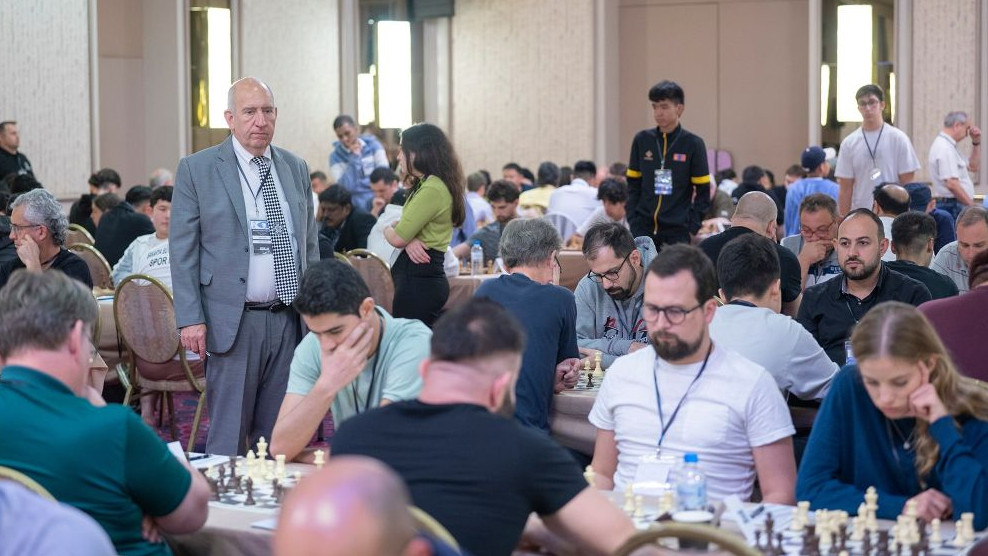
The World Amateur Chess Championship in Rhodes has reached an electrifying midpoint, with players displaying tenacity and skill. The event, held under the auspices of FIDE, has drawn an impressive field of amateur players from around the globe, each vying for a place in chess history on this storied island. In the U2300 and W1700 we have sole leadership by CM A Kumaresh from India, scoring 4.5 out of 5 (2048 rating, 2470 performance rating – No22 of the U2300 starting list) and AIM Anastasiia Osadchuk from Ukraine, netting 5 out of 5 (0 rating, 2180 performance rating – No 16 of the W1700 starting list). In the U 2000 section Ganbat Danzanjunai, Nurasyl Zhumabek & Tsogtsaikhan Saikhanchimeg from Mongolia, CM Pankaj Sharma from India & Daniel Perez Gonzalez from Spain co-lead with 4.5 points out of 5. Victor Gnevyshev and Lkhagvagaram Sumiya jointly lead U 1700 section with the perfect score of 5/5. Detailed results for each category are available at the following links: U2300, U2000, U1700, W1700 Many games have stretched to the final seconds, highlighting the dedication and stamina of the players. With only a few rounds remaining, the pressure is mounting as each move becomes critical in determining who will take home the title in their category. The games are broadcast live on the Lichess platform at these links: U2300, U2000, U1700, W1700 The World Amateur Championship is an official event of the International Chess Federation (FIDE), co-organized by the Rhodes Chess Club “Ippotis,” the South Aegean Region, the Municipality of Rhodes, and the Hellenic Chess Federation (ESO). Our gratitude goes to the South Aegean Region, Governor George Hatzimarkos & Deputy Governor for Sports Akis Delaporta, RODOS PALACE Hotel 5*, Antonis Kampourakis of Xenakis Mobility, Melissokomiki Dodecanese, J@D Rent a Car, At Holidays, the accounting firm “Papadimitriou & Partners,” and Ilektrodome S.A. for their unwavering support. Photos, content, and additional materials from the Championship can be found on the social media pages of the Rhodes Chess Club “Ippotis.” Website: ippotis.comFacebook: facebook.com/rhodeschessevents/Instagram: instagram.com/rhodes_chess_events/YouTube: youtube.com/@rhodes_chess_events Photos: Jim Laga
FIDE Trainer Awards 2024 – Call for nominations

The International Chess Federation (FIDE) and the FIDE Trainers’ Commission (TRG) are pleased to announce the 16th FIDE Trainer Awards 2024. These awards aim to recognize and celebrate the outstanding achievements of the chess training community. Mikhail Botvinnik Award for the best achievement by trainer(s) in open-section competitions Vakhtang Karseladze Award for the best achievement by trainer(s) in women’s and/or girl’s competitions Mark Dvoretsky Award for the best achievement by trainer(s) in junior competitions Trainer Nominations The awards must be granted for achievements in the year 2023. Only licensed trainers are eligible. The following are eligible to make nominations: a) FIDE Council Membersb) Continental & National Chess Federationsc) TRG Commission Membersd) Principals of FIDE Academiese) FIDE Senior Trainersf) Former Winners No nominator can nominate the same individual in more than one category. All nominations must be sent to TRG by November 21, 2024 Nomination Form
FIDE WGP Shymkent: Tan Zhongyi takes the lead after Round 3
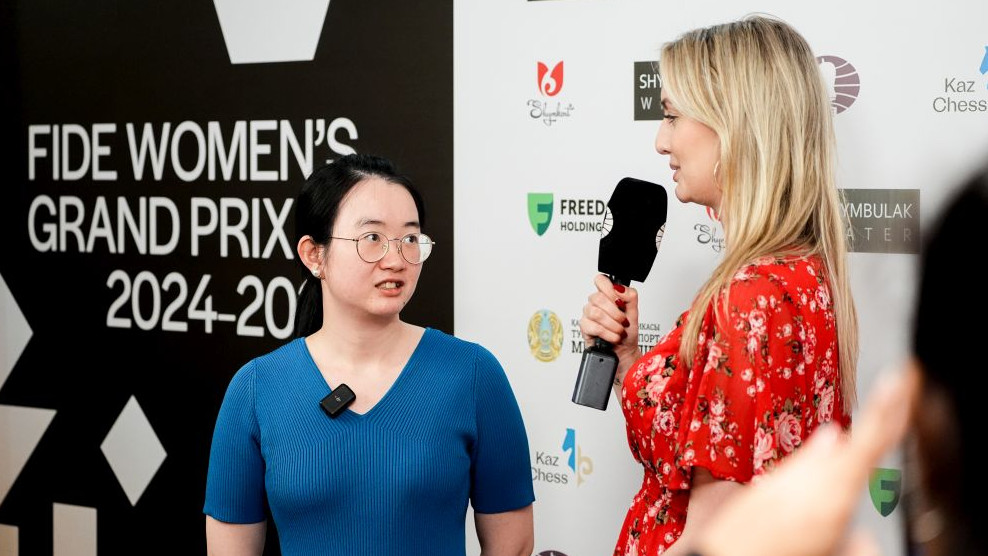
Round 3 of the FIDE Women’s Grand Prix saw intense battles across the boards, with three of the five games ending decisively. Aleksandra Goryachkina and Humpy Koneru each scored their first wins, prevailing over Divya Deshmukh and Munguntuul Batkhuyag, respectively. Tan Zhongyi seized the tournament lead, capitalizing on Kateryna Lagno’s missteps in a convincing victory that showcased her calculated precision. While still early in the tournament, Round 3 was a critical turning point for many players as they pushed to solidify positions on the leaderboard. Joint leaders Bibisara Assaubayeva and Stavroula Tsolakidou played a nail-biting game, ultimately drawing after a hard-fought tactical battle. Tan Zhongyi, the third co-leader entering the round, emerged victorious over Lagno, who misplayed early in the opening. On the other boards, Aleksandra Goryachkina outplayed Divya Deshmukh, Humpy Koneru punished Munguntuul Batkhuyag’s blunder, and Nurgyul Salimova and Elisabeth Paehtz drew without too much commotion. Bibisara Assaubayeva – Stavroula Tsolakidou ½ – ½ This was definitely the game of the round to watch, and it was a great battle from the start, so much so that our commentators remarked that it showed the highest level of chess in this event so far. In a King’s Indian, Bibisara sacrificed a pawn early to unlock her kingside attack, castling queenside ensuring a dynamic game – something we have seen before. The game became extremely tactical, with both players setting up minefields for each other, giving up pawns and pieces left, right, and center, and playing with precision. That is until move 27, when Bibisara perhaps overlooked Stavroula’s intermediate moves before trading queens, leading to an endgame where Black had an extra passed pawn. It was a complicated endgame, and even though Stavroula was better, it was not easy to advance. The tense game ultimately settled into a draw, leaving both players with a hard-earned half-point. Divya, Deshmukh – Goryachkina, Aleksandra 0-1 In a classic experience vs. youth match, Goryachkina demonstrated why she’s a seasoned contender on the FIDE Women’s Grand Prix circuit. It started off calmly, with Goryachkina remarking that it seemed as if her opponent was playing for a draw. But experience was perhaps a key factor here, as Goryachkina slowly kept improving her position, refusing the trade of queens, and bringing all of her pieces to the optimal squares. Eventually, the white queen found itself locked out of the game, with her pieces just not working together very well, and eventually, she just crumbled. Black’s knight had a wonderful world tour around the board, with all the other pieces also optimally placed, coming in to execute a lethal attack along the dark squares. Under pressure and facing time trouble, Divya struggled to defend her position, but her efforts were enough only to reach time control when she resigned. Tan, Zhongyi – Lagno, Kateryna 1-0 The game started out as a London System, with Black avoiding all main lines. Lagno traded off White’s key bishop on f4 but ended up in a dubious position, giving up a pawn she couldn’t reclaim. Things went from bad to worse as White completely dominated the game with principled play, eventually finding a wonderful Knight sacrifice on move 23, which she spent over 20 minutes on. 21.Nxe6! With a +3 advantage, it was hopeless for Lagno very soon, but Kateryna made her opponent work for the point, setting up drawing traps along the way. But Tan clung to the advantage, sidestepping the tricks and traps, and drove the victory home. This win has placed Tan as the sole leader of the pack, as she leads by half a point. Her record has proven her to hold such leads quite well, and it will be interesting to see if she keeps it up. Munguntuul, Batkhuyag – Koneru, Humpy 0-1 Munguntuul was round two’s only victor, but today she lost her game after what Humpy noted as “following the incorrect plan” in the Ruy Lopez, failing to find the best squares for her pieces. By move 19, Black had a significant advantage, and Humpy fully capitalized on her opponent’s mistake, playing flawlessly all the way up to move 32 when Munguuntul accepted her fate and resigned. This bounce-back victory was critical for Koneru, who was determined to recover from a missed opportunity in her prior game against Tan. She remarked that the game kept her up last night as she was so upset with herself (sometimes drawing a winning position hurts more than a loss), but she was able to maintain composure and secure this important win. Salimova, Nurgyul – Paehtz, Elisabeth 1/2-1/2 Another clash of generations, the game between Salimova and Paehtz was smooth sailing for both sides. With a few early piece trades, neither player launched any aggressive attack but rather maneuvered their pieces well, where the positional nature of the game led to a natural draw. This is Paehtz’s first half-point on the scoreboard, after her difficult round one and two losses against Tan and Munguuntul. Despite these setbacks, she seemed to still enter her third round in a good mood. It is perhaps this quality that enabled her to achieve the Grandmaster title in 2022 at the age of 37, making her the first German woman to do so. Nurgyul also had a rough start after losing to Bibisara in round one and missing some chances against Stavroula in round two, but in an interview, she said that she is focusing on steady improvement and taking it game by game. All players now have points on the leaderboard, with Tan Zhongyi as the sole leader with 2.5 points. Trailing just a half-point behind here are Assaubayeva, Koneru, Tsolakidou, and Goryachkina with 2 points each. Moment of the Day There were many great moments today, with instructive tactics here and there, but a particular position stands out because of the accuracy with which both players handled it: Assaubayeva – Tsolakidou White has just played 23.f4, and after thinking for 24 minutes, Stavroula responded with the only move 23…cxd5! Giving up the knight on g5, and
FIDE November 2024 rating list published
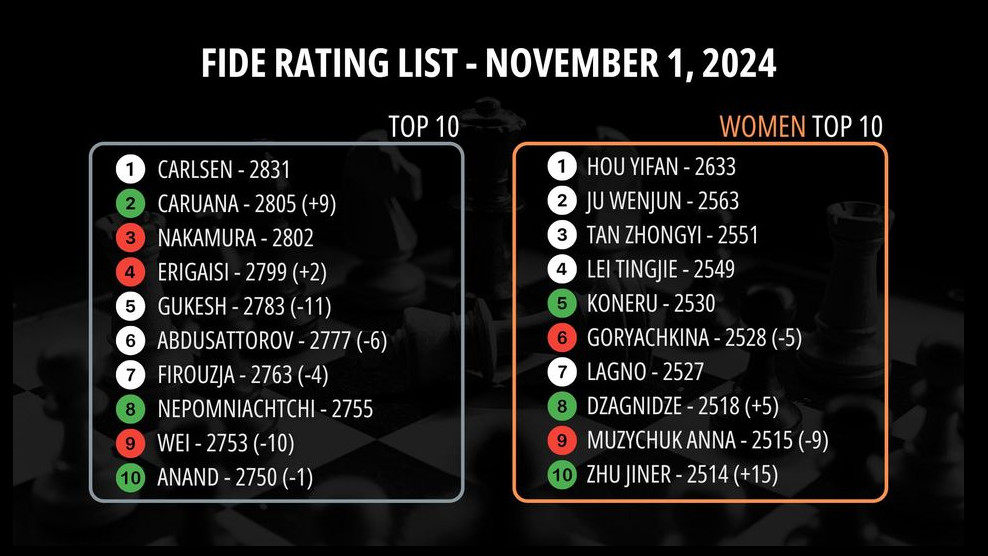
October 2024 saw the 2024 U.S. Championships and several major club competitions, including the European Club Cup (open and women’s tournaments). These events had the most significant impact on the FIDE November 2024 rating list. After successfully defending his U.S. Championship title, Fabiano Caruana picked up 9 rating points, reclaimed the second position on the list, and returned to the elite 2800+ rating group after a four-month absence. Photo: Saint Louis Chess Club | Crystal Fuller Arjun Erigaisi, who gained two rating points in October, came close to reaching the 2800 milestone and becoming the 15th player in history to achieve it, falling just one point short. The native of Warangal, Telangana, has been on a steep upward trajectory all year and is likely to cross the 2800 mark very soon. The most notable change in the Women’s top 10 was Zhu Jiner’s ascent, as she gained 15 points while playing for the gold-winning TAJFUN-ŠK Ljubljana at the 28th European Women’s Club Cup. Over the past four months, the young Chinese Grandmaster has increased her rating by 35 points, reentering the top 10 after a five-year hiatus. Photo: European Chess Club Cup Biggest Gains in the Top 100 Open and Women Gaal, Zsoka WIM HUN 2425 (+27) Shuvalova, Polina IM FID 2495 (+23) Kiolbasa, Oliwia IM POL 2374 (+23) Sadhwani, Raunak GM IND 2677 (+18) Murzin, Volodar GM FID 2664 (+16) Zhu, Jiner GM CHN 2514 (+15) Fedoseev, Vladimir GM SLO 2712 (+14) Yakubboev, Nodirbek GM UZB 2668 (+14) Sindarov, Javokhir GM UZB 2682 (+14) Yip, Carissa IM USA 2432 (+14) Vidit, Santosh Gujrathi GM IND 2739 (+13) Zsoka Gaal (pictured below) delivered an outstanding performance, playing for the runner-up Garuda Ajka BSK at the 28th European Club Cup for Women. Her efforts translated into a 27-point rating increase, making her the biggest rating gainer in October. Photo: European Chess Club Cup Oliwia Kiolbasa did not participate in the major club event of the year, yet still collected 23 points in her home league, the Polish Team Championship – Ekstraliga 2024. Nodirbek Yakubboev (+14), Javokhir Sindarov (+7), and Vidit Gujrathi (+6) were the primary rating beneficiaries of the 39th European Club Cup, while Volodar Murzin (+12) and Vladimir Fedoseev (+12) performed strongly in Spain’s Ceclub Division de Honor. Photo: Niki Riga Raunak Sadhwani (pictured above) got a substantial rating boost following his successful performance at the W.R. Chess Masters Cup (+13) where he gained the most points. Just like Fabiano Caruana, Carissa Yip defended her title at the U.S. Women’s Championship, earning 14 rating points. The U.S. Women’s Champion has reached a career high and is now one step away from the Women’s top 30.
FIDE WGP Shymkent Round 2: Munguntuul stuns Paehtz in a 17-move upset
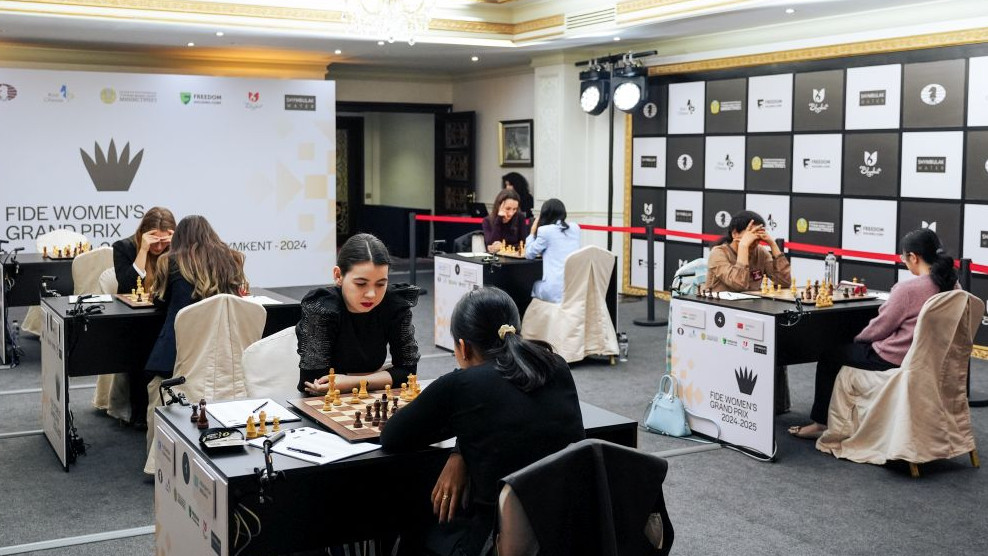
The second round of the FIDE Women’s Grand Prix in Shymkent saw a quieter day on the scoreboard, but there was no lack of drama on the boards. Most games ended in draws, yet Munguntuul Batkhuyag delivered a stunning upset, defeating higher seed Elisabeth Paehtz in only 17 moves—a swift victory secured within just over an hour. We saw a lot of fighting chess in the first round of the tournament. Despite multiple draws, this trend continued as the day had a lot of exciting games with fluctuating engine evaluations, blunders, and brilliancies. Elisabeth Paehtz – Batkhuyag Munguntuul 0-1 What started as a timid Caro-Kann quickly developed into an aggressive game with opposite-side castling with players executing attacks on the different sides of the board. Elisabeth, who lost a very long 5.5-hour game to Tan Zhongyi in the first round, was clearly pushing for the win, storming her pawns down the kingside. But Munguntuul, who said in an interview that she was well-prepared, handled the attack perfectly and seized the winning moment after Elisabeth’s fateful blunder of 17.Ng5, which was swiftly responded to with the winning 17…Ba3!! A move that White completely overlooked. Elisabeth capitulated since 18.bxa3 is met with 18…Nc3 and after 19.Bxc3 dxc3 it is game over. 0-1 This is not Munguntuul’s first rodeo at a FIDE Women’s Grand Prix, as she participated in the 2009/2010 and 2011/2012 series. She starts this leg off as the lowest seed, which she admitted makes her nervous, but after such a good second-round bounce back, she is clearly in form. Aleksandra Goryachkina – Bibisara Assaubayeva 1/2-1/2 Similarly to her first round, Aleksandra opted for a less-played opening line, this time in the Ruy Lopez. However, Bibisara seemed to be familiar with it, blitzing all her moves accurately and keeping her time above the start hour and a half, all until the novelty on move 11: 1. e4 e5 2. Nf3 Nc6 3. Bb5 a6 4. Ba4 Nf6 5. O-O d6 6. Bxc6+ bxc6 7. Re1 Bg4 8. h3 Bxf3 9. Qxf3 Nd7 10. Na3 g6 11.b4 Whether this was preparation or merely just played over the board, it clearly stumped the Kazakhstani player, who would take almost 9 minutes to respond with 11…Bg7. A few moves later, White attained a sizable advantage after Black played incorrectly: White is slightly better, with more active pieces, but all Black had to do was protect the c7-pawn with 18…Rc8. However, after 18…c5?, White gained a significant advantage, as the black pawn structure was weakened, and White’s bishop came to life via a5. However, Aleksandra made several inaccuracies and let her advantage slip away. The position fully equalized after the erroneous 25.Qxd6? This seems like the logical capture, giving Black weak central pawns, but better was 25.Qxe4 followed by Qc6, keeping the queens on the board, maintaining pressure, and not allowing Black’s Rook any activity. The latter is exactly what happened after 25…Qxd6 26.Bxd6 Rd8 27.Bxc5 Rc8 28.Be3 Rxc2. Suddenly, Black’s pieces were in the game, and a three-fold repetition occurred a few moves later. Tsolakidou, Stavroula – Salimova, Nurgyul 1/2-1/2 Two of the younger participants reached an interesting position in the Italian, where Nurgyul had an opportunity to shake things up tactically with a bishop sacrifice: Here 16…Bxh3! is Black’s top move, starting fireworks on the kingside. White’s best response would be to decline the sacrifice with a move like 17.Ne4, but if instead 17.gxh3 was played, suddenly things take a dangerous turn after 17…Qd7, followed by Qxh3, and White will be under pressure to defend with precision. However, it is easy to spot this with computer evaluation on hand, but at the board, this was perhaps not clear enough for Salimova. She instead opted for 16…cxd5, eventually gaining a slight advantage and comfortable position. Another critical moment came on move 37 where Black had an opportunity to secure a clear advantage: Salimova played 37…Ke6, attacking White’s good Knight, which was necessary in order to relieve the black e8-knight from its defensive duties and passivity on the back rank. However, this was the incorrect way as after 38.g4 the Knight stayed put. Salimova tried 38…g6 39.Nxh6 Be3 40.Ng8 but this was not enough as there was no way to make progress. The opponents eventually repeated moves and called it a draw. Instead, 37…Be6 was the better way to attack the Knight. 38.g4 is no longer as attractive, making the 38.Ng3 retreat White’s only option. Now, importantly, the black King heads to the queenside via c6, threatening Bc5, eventually picking up the a-pawn. This continuation looks much more promising for Black. Nurgyul missed her chance to take down one of the tournament leaders, but a draw is still a good way to recover from her first-round loss to Assaubayeva. Koneru, Humpy – Tan, Zhongyi Tan Zhongyi was once again one of the last players to leave the tournament hall in what was another long game. Humpy snatched a pawn relatively early, but Tan played actively and White never had any major advantage for the most part. But the tides changed on move 27, and in a rare occurrence, as Tan blundered! Here 27…Qe4 was Black’s only way to maintain equality, keeping the Queen active and creating threats on both e3 and g2. After a move like 28.Bd4 defending e3, suddenly 28…Rxg2 is possible and after 29.Qxg2 Qb1+ it becomes check galore, and a draw is inevitable. Tan, however, played 27…Qc8?? Allowing White to activate the Queen with 28.Qd3, and suddenly, things become very dangerous for Black. 28…Qc6 was played, and here 29.e4! was crushing as a back-rank checkmate was looming, and Black would have to, therefore, lose the pawn. After spending almost five minutes thinking here, Humpy played 29.Bc3? The engine would continue to see-saw up and down between equality and an advantage for White, eventually reaching this final critical position on move 39, one move away from the added 30 minutes, and the game was in Humpy’s hands. The correct capture was 40.exf4 as after 40…Qxg2, White has
A promising start: Three victories in Round 1 of WGP Shymkent
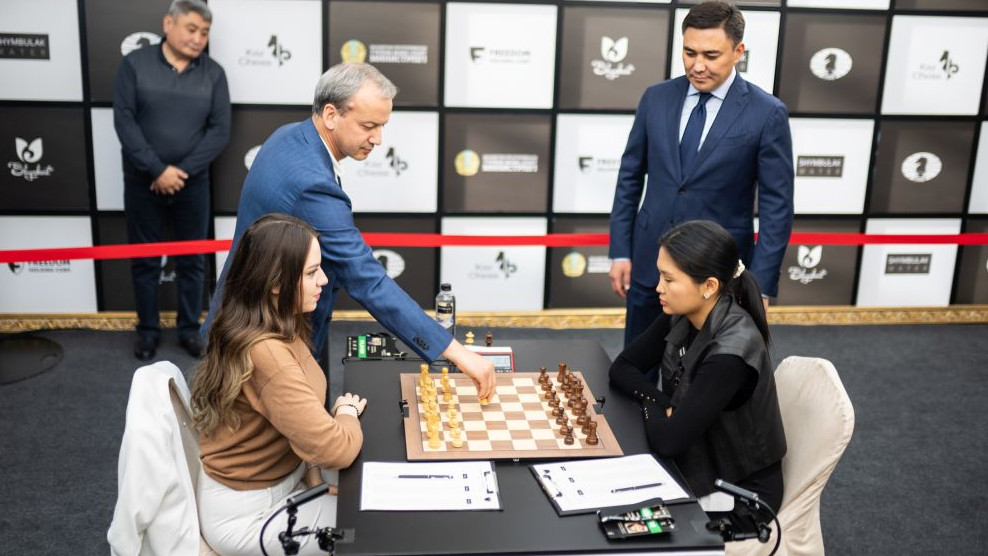
The first round of the second leg of the Women’s Grand Prix in Kazakhstan was filled with twists and turns, where three players – Bibisara Assaubayeva, Stavroula Tsolakidou, and Tan Zhongyi secured wins. As the clock neared 15:00, players entered the elegant hall on the 11th floor of the Rixos Khadisha Hotel, with its chandeliered grandeur and golden accents that perfectly captured the prestige of the occasion. Tension filled the air as players settled into their seats, ready for the battles ahead. The ceremonial first move was made by Gabit Abdimazhitovich Syzdykbekov, Mayor of Shymkent, on board one between Nurgyul Salimova and Bibisara Assaubayeva—marking the board where the first victory of the day would later unfold. The opening round’s decisive outcomes included Stavroula Tsolakidou’s win against Batkhuyag Munguntuul and Tan Zhongyi’s hard-fought victory over Elisabeth Paehtz, the last game to conclude after intense 5.5 hours of play. For fair play, players from the same country were paired together in the first round which was the case between Kateryna Lagno vs. Aleksandra Goryachkina, Divya Deshmukh vs. Humpy Koneru, where both games ended in draws. With the majority of games ending decisively, and even the drawn games being far from boring, the day was filled with exciting chess. Let’s take a closer look: Nurgyul Salimova vs. Bibisara Assaubayeva 0-1 Playing with the black pieces, homegrown hero Bibisara opted for an aggressive approach to White’s early kingside castle by storming the h-pawn down the h-file. Bibisara’s opening approach was a good one – she took Nurgyul out of her usual Catalan comfort zone and into unfamiliar territory. Although Black did not have a concrete advantage, she was clearly steering the ship. Eventually Nurgyul slipped by untimely returning a pawn and found herself in an inferior position. The critical moment of the game came on move 21. Here Salimova could have protected both her dark-squared bishop and the b2-pawn by 21. Qc1 with an unpleasant but still holdable position. Instead, she played 21. Bf2? but Bibisara snatched a pawn with 21…Nxb2. White could have put up a stubborn resistance but after several inaccuracies by Nurgyul, Bibisara traded off most of the pieces and liquidated into a winning endgame. After the additional 30 minutes was added by move 41, Salimova, who had been playing with a minute or less for 10 moves, finally had time to properly assess the position, and after some thought resigned. This victory was important for Bibisara, as not only does it give her a strong start, but she was able to secure the point with the black pieces. After her game, she exclaimed in an interview that this was her first win with black in her last 3–4 tournaments! Playing in her home country of Kazakhstan, she has both additional pressure and support, and with such a dominant start, she is definitely one of the tournament favorites. Kateryna Lagno vs. Aleksandra Goryachkina 1/2-1/2 The rollercoaster game between Lagno and Goryachkina started off as a regular Giuco Piano, an opening that commentator Miro noted as having too many familiar positions that all seem the same. Goryachkina opted for the less popular 6…a5 and later started aggressive kingside play that would never materialize into any kind of advantage. In fact, the opposite occurred – Lagno secured her kingside and started pushing on the queenside. By move 30, she achieved a winning position. Although it looks scary, White’s king is safe and the computer evaluates this as a +9 advantage for White after 31.Qxd6. Indeed, Black can’t create any real threats after capturing on g2. For example 31. Qxd6 Bxg2+ 32. Bxg2 Rxg2 33. Rxg2 Rxg2 34. Qd8+! Kh7 35. Nf3! However, Kateryna erred, possibly overestimating Black’s attack and instead opted for 31.Qh4+. After 31…Rh6 32.Rxe7 Rxh4 33.Rxg7 Bxg2+ 34.Bxg2 the position became completely equal. But the twists did not end there – a few moves later, White seized an advantage once again in the form of a dangerous d-passer, but under time pressure, and a couple of moves before reaching time control Lagno blundered, and the game shortly ended in a draw. Batkhuyag Munguntuul vs. Stavroula Tsolakidou 0-1 In what was another lengthy game, Stavroula playing with the black pieces, reached a comfortable position out of the opening and emerged slightly better in an opposite-colored bishop endgame with rooks. Tsolakidou was probing Munguntuul’s defenses for a while and eventually got her chance. First, White retreated her bishop from active position and then made the major mistake by moving the king into the wrong direction: 50.Ke1? (50. Bh5 with the idea of 50…Rh7 51.g4 was the only chance) allowed Black to infiltrate the kingside with 50…Rh7 followed by Rh1-Rg1, eventually picking up the g-pawn. White tried to create some queenside counterplay, but to no avail. Eventually, Black’s g-pawn ran down the board to glory, securing an early win for Stavroula. Divya Deshmukh vs. Humpy Koneru 1/2-1/2 The game between Divya and Humpy was an exiciting clash of generations – Divya, a recent double gold Olympiad medalist for Indian, and Humpy, a titan in Indian chess. Both players played accurately, and after 41 moves the game ended in a quiet draw. Tan Zhongyi vs. Elisabeth Paehtz 1-0 The last game to end was between Tan Zhongyi and Elisabeth Paehtz, spanning 107 moves over more than 5 hours. Despite a relatively early exchange of queens, the position was balanced but full of life. However, on move 33 instead of 33…Rc3 Paehtz made the bold decision to play 33…Nxg4 hoping for 34.hxg4 Bxg4. However, Tan first inserted the zwischenzug 34.Nc6 threatening Nxe7, securing an outpost, and completely restricting the mobility of the black Rooks. White continued to hold a minor advantage for most of the game, but eventually equality was reached with White having three active minor pieces – two bishops and a knight, versus Black’s two rooks. The final mistake came on move 67 where Black played 67…Ra8? (instead of 67…Rg8!), saving the wrong Rook and allowing White to keep the dominating knight. After 68.Bxf8 Rxf8 69.Bxf5,
Experience the thrill of FIDE World Chess Championship live in Singapore!

Join us in Singapore for the World Chess Championship and witness chess history in the making! Take advantage of specially curated travel packages, each combining exclusive access to the title match with unique attractions, and save up to 30% off. Choose from stays at top hotels, enjoy theme park entry, and immerse yourself in the magic of chess surrounded by Singapore’s vibrant culture. Packages Hotel Ora + Universal Studios Singapore + FIDE World Championship 2024 Two nights stay at Hotel Ora in a Deluxe Room with buffet breakfast Universal Studios Singapore entry FIDE World Championship standard day pass Cost: Single occupancy at S$870 (normal price S$1,200) Double occupancy (with entry for 2) at S$1,000 (normal price S$1,340) Village Hotel Sentosa + Universal Studios Singapore + FIDE World Championship 2024 Two nights stay at Village Hotel Sentosa in a Deluxe Room with buffet breakfast Universal Studios Singapore entry FIDE World Championship standard day pass Cost: Single occupancy at S$650 (normal price S$915) Double occupancy (with entry for 2) at S$790 (normal price S$1,125) Travelodge Harbourfront + Adventure Cove + FIDE World Championship 2024 Two nights stay at Travelodge Harbourfront in a Deluxe Queen with breakfast Adventure Cove entry FIDE World Championship standard day pass Cost: Single occupancy at S$480 (normal price S$800) Double occupancy (with entry for 2) at S$560 (normal price S$880) Singapore is preparing to welcome chess fans from around the world to take part in this exciting chess experience where you will get to witness the high-stakes match whilst enjoying the surrounding resorts and activities. Book your package and get ready for a chess vacation like no other. For more information, visit the official website. About the FIDE World Championship Match The FIDE World Championship Match is one of the most important and widely watched chess events globally. Held every two years, it features the defending World Champion and the Challenger, chosen through a qualification process culminating in the Candidates Tournament, which includes eight of the world’s top players. The defending Champion is Ding Liren, who won the title after defeating Ian Nepomniachtchi in Astana, Kazakhstan, in April 2023 on tiebreaks. The Challenger is the 18-year-old Gukesh D from India, who won the Candidates Tournament in April 2024 in Toronto. The World Championship Match will consist of 14 games. The player who scores 7.5 points or more wins the Match, and no further games are played. If the score is equal after 14 games, the winner is decided by a tiebreak.
Second leg of FIDE Women’s Grand Prix 2024-2025 kicks off in Shymkent
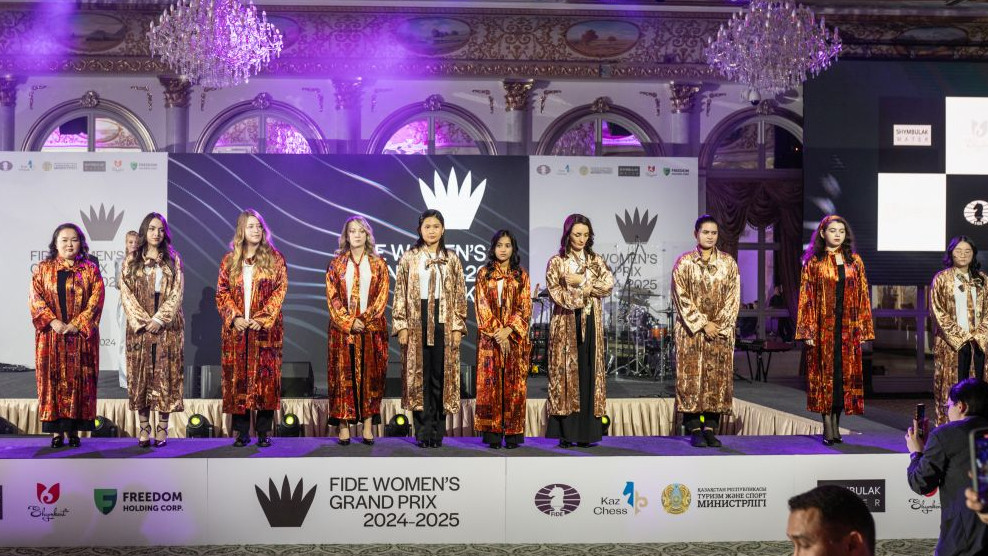
Kazakhstan has emerged as a powerhouse in women’s chess, proudly represented by stars like Bibisara Assaubayeva, a two-time Women’s World Blitz Chess Champion, and the Kazakh women’s team, who recently claimed silver at the 2024 FIDE Olympiad. It is thus fitting that Kazakhstan hosts the second leg of the prestigious FIDE Women’s Grand Prix, a cornerstone competition in the women’s chess calendar. Starting October 30, 2024, ten of the world’s top female players will compete in Shymkent in a round-robin format, vying not only for victory but also for crucial Grand Prix points that impact their qualification for the upcoming FIDE Candidates Tournament. This elite lineup includes renowned players such as Bibisara Assaubayeva, Aleksandra Goryachkina, Stavroula Tsolakidou, Humpy Koneru, Kateryna Lagno, Tan Zhongyi, Nurgyul Salimova, Batkhuyag Munguntuul, Elisabeth Paehtz, and Divya Deshmukh. With a mix of seasoned veterans and rising stars, fans can anticipate a thrilling display of skill and intense games. The tournament commenced with an elegant opening ceremony at the Rixos Khadisha Hotel, where the playing hall is located. The evening opened with a captivating traditional dance, followed by a tribute to each participant. Players were invited to the stage as their achievements were announced, each donning attire by renowned designer Aida Kaumenova, inspired by Kazakh traditions. The event was graced by distinguished guests, including FIDE President Arkady Dvorkovich, Vice President of the Kazakhstan Chess Federation Marat Yessenov, and Shymkent’s First Deputy Akim Kuanysh Asylov, all of whom addressed the audience with inspiring words. President Dvorkovich expressed his hopes for fierce competition and commended Kazakhstan’s remarkable progress in the chess world, stating, “Kazakhstan’s success story is the culmination of joint efforts by the government, regional authorities, the Chess Federation, and supporters across the chess community. I hope this model inspires others globally.” Kuanysh Asylov, in his remarks, thanked FIDE for selecting Shymkent as the host city. “For our city with more than 2000 years of chess tradition, this is a great honor. We have many chess clubs in our city, and chess as a subject is taught in schools. All this is a merit of our cooperation with the International Chess Federation and the results of support from the country’s leadership.” In addition to speeches and performances, the ceremony featured a fashion show by Aida Kaumenova, showcasing designs that echo the strategic and artistic elements of chess. The evening was a spectacular celebration of Kazakh chess passion and a fitting tribute to the players. Round 1 begins Wednesday at 15:00 local time, with a time control of 90 minutes for the first 40 moves, followed by 30 minutes for the rest of the game, with a 30-second increment per move starting from move one. Round 1 Pairings: Kateryna Lagno vs. Aleksandra GoryachkinaDivya Deshmukh vs. Humpy KoneruTan Zhongyi vs. Elisabeth PaehtzBatkhuyag Munguntuul vs. Stavroula TsolakidouNurgyul Salimova vs. Bibisara Assaubayeva For more information about the event, including news, images, regulations, pairings, and games, please visit womengrandprix.fide.com/ Written by Charlize van Zyl Photos: Konstantin Chalabov and Viktoriya Abramova
World Youth Championship 2024 commences in Florianópolis

The world’s best chess players under 18 have gathered in Florianópolis, Brazil, for the 2024 World Youth Chess Championship (WYCC), held at the Canasvieiras Internacional Hotel from October 28 to November 10. The opening ceremony took place on Tuesday at the venue. A total of 527 players, including 150 titled players, from 62 countries—among them the United States, India, France, Spain, Georgia, China, Norway, Germany, Kazakhstan, and Poland—are competing in this year’s event. Host nation Brazil has the largest representation with 97 players. Organized by FIDE in collaboration with the Brazilian Chess Confederation (CBX) and led by Chief Arbiter IA Kaiser Luiz Mafra, the championship features three age categories (Under 14, 16, and 18) in both open and girls’ divisions, with six 11-round Swiss tournaments with classical time control running simultaneously. Following international organizational standards, the venue is equipped with metal detectors to prevent unauthorized electronic devices. The event is supported by a skilled team of FIDE arbiters and technical staff. The first World Youth Chess Solving Championship will be held during the WYCC on November 4, mirroring the age and gender categories of the main event.Registration is open via email at worldyouth@fide.com. Written by Liziane Nathália Vicenzi Photo: André Gemmer

